PinotFile: 12.9 October 6, 2020
|
An Investigation of Alcohol Levels of California & Oregon Pinot Noir since 2004
To accomplish maximum flavor development, grapes are left to hang long into the growing season with the result that sugar accumulation (Brix) increases markedly. High sugar, of course, translates into high alcohol percentage (ABV) in the finished wines. For every gram of sugar that is converted to alcohol during fermentation about half a gram of alcohol is produced. The alcohol conversion factor can be between 0.55 to 0.64. Grapes picked at 22.5º will have a potential ABV of 13.0, while grapes picked at 25.8º will translate to an ABV of 15.1. Many notable wine critics pointed out the significant rise in alcohol levels over the decades prior to 2008. A study in California showed that average alcohol levels in wine rose from 12.7% in 1971 to 14.8% in 2001, the result of the average Brix at harvest increasing from 20.5º in 1971 to 24.2º in 2001. California had become a leader in higher alcohol wines due to several factors but primarily the warm climate, viticultural advances, low yields, more efficient yeasts that survive at higher levels of alcohol and the high scores that this style of wine garnered from wine critics, the so-called “Parker effect.” Studies have shown that climate is not as significant as the demand for more intense or riper-flavored wines. The result was more sales of wine and resultant economic success.
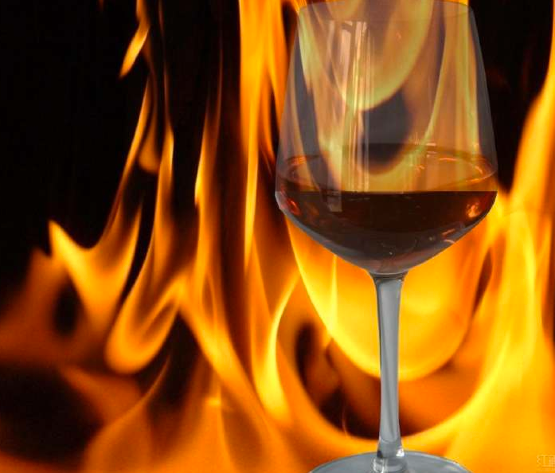 Two popular technologies for reducing alcohol levels in wine were in wide use with reportedly half of all California wines said to undergo some type of technological alcohol reduction. Vinovation championed the process of reverse osmosis beginning in 1992 and ConeTech introduced the Spinning Cone Column (SCC) in 1991. ConeTech claimed the SCC technology-enabled precise adjustment of the wine’s alcohol level while achieving the “sweet spot” between 12% and 14% that resulted in wines of balance without changing the wine’s natural flavor. Vintners would typically reduce the alcohol in a portion of the vintage and then blend that reduced-alcohol wine back into the unreduced wine to achieve a more ideal alcohol percentage (ABV). Alcohol adjustment continues to this day but no one willingly talks about it for fear the consumer would judge the wine as inferior. Other options to reduce alcohol levels available to vintners include filtering and diluting the wine with water. With Pinot Noir, in particular, these procedures often sacrifice flavor and mouthfeel and significantly change the structure of the wine. Looking back over recent vintages of California Pinot Noir, I have observed a trend toward lower alcohol levels in wines in general and particularly Pinot Noir, I have observed this because I pay serious attention to the ABV in Pinot Noirs I purchase for personal pleasure, preferring those wines below 14.0% ABV. These wines have more appealing aromatic profiles that are not dulled by very ripe fruit, more desirable acidity and resultant juiciness, and are simply more nuanced and pleasurable. Alcohol has no taste per se, but at higher levels, it can overpower the palate. It also leads to alcoholic warmth or “devil’s spit” that accompanies many Pinot Noir wines over 14.5% ABV. Allowing for TTB regulations that permit a 1.0% inaccuracy in wines over 14.0% ABV, many of these hefty 14.5% and above ABV labeled Pinot Noir wines are actually well over 15% ABV. Wines can have and often do have significantly more alcohol than the stated percentage on the label. I love the quote by Ron Washam HMW: “Taking the alcohol listed on the label seriously is like believing the guy’s height or the woman’s weight on match.com. The wine is always going to be shorter and fatter than you expected.” Surveys have indicated that alcohol levels are usually not a factor when consumers choose a wine. Many wine drinkers do not even realize that the alcohol percentage in the bottle is written in tiny print on the front or back label. Considering this, maybe it is a moot point to argue about the merits of higher versus lower alcohol in Pinot Noir. Some consumers even equate high alcohol with quality. Others are unfazed by higher alcohols because tolerance is determined genetically. 50% of the population have one dominant and one recessive gene for taste and are termed “regular” tasters. They choose moderate flavors and are only mildly sensitive to tannin, sugar and high alcohol. 25% of the population are recessive for both genes and are called “non-tasters.” They prefer intense tastes, sweet wines and heavy alcohol. The remaining 25% have two dominant genes for taste and are termed “supertasters.” They prefer softer flavors in wine and disdain sweet wines, heavy tannins and high alcohol. There are a greater number of women and Asians who are supertasters. Some writers have pointed out that vintners have gone a little too far in avoiding overly alcoholic wines. Australian James Lawrence posted in wine-searcher.com on September 9, 2020, “The problem today isn’t a rash of alcoholic fruit bombs, it’s the rise of underripe, charmless wines. Some growers are attempting to subjugate terroir and make lighter wines in spite of what nature is throwing at them. We’ve swapped alcoholic monsters for mean-spirited, sulky wines.” I agree with Lawrence that I am now seeing examples of California Pinot Noir with alcohol levels in the 12.0 to 12.5 range and some of these wines are simply too lean and austere for my taste. Vegetal notes are evident because the grapes have been picked before physiological ripeness. The wines are extremely acid-driven and may risking appeal to the consumer that likes body and sweetness fruit in wine. Oregon Pinot Noir has not typically been overly alcoholic except in some unusually hot vintages such as 2003, 2006 and 2012. In cooler vintages, Oregon Pinot Noir barely averages 13.0% ABV. The classic growing season climate in Oregon is generally more compatible with lower Brix at harvest and higher acidity. I tallied the ABV of all of the California and Oregon Pinot Noir wines I reviewed from 2004 through 2018 vintages for California and 2004 through 2017 vintages for Oregon and digested the statistics. I believe this data is unique since I was the first wine critic to include ABV in my reviews dating back to 2004, something that other popular wine magazines have now incorporated into their wine reviews. When available, I used the ABV stated on the wine’s tech sheet rather than the label but they are often the same.
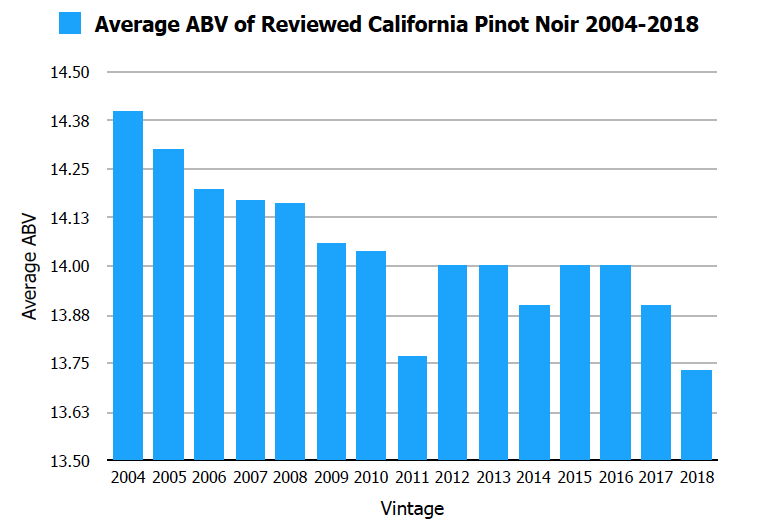
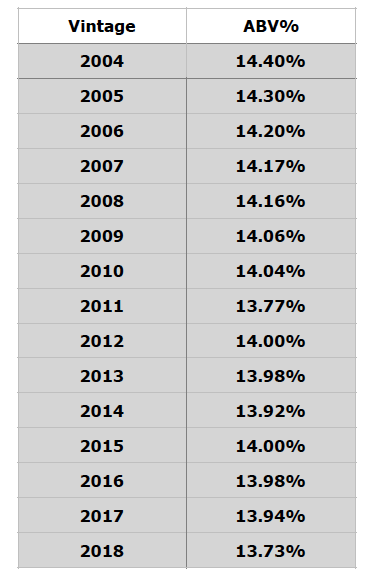


What conclusions can we draw from this study?
(1) Over the 14-year period surveyed from 2004 to 2018, the average ABV of California Pinot Noir decreased by about 1.0%. The drought years of 2011-2019 may have played a role in this decrease although the growing seasons during this time period have become warmer due to climate change. The decrease hints, but does not prove, that wineries and winemakers through viticulture, picking decisions and winemaking have made a concerted effort to decrease ABV of California Pinot Noir in more recent vintages. Pinot Noir wines with a high ABV above 14.0% are often labeled as less than the true ABV since up to a 1.0% reduction is allowable under TBB regulations as long as the ABV is kept above 14.0%. This allows wineries to fudge a bit to avoid the undesirable perception of higher alcohol content. (2) Over the 13 year period surveyed from 2004 to 2017 (I did not have enough 2018 Oregon reviews for statistical significance but it should be noted that this was a very warm growing season), the average ABV of Oregon Pinot Noir showed no decrease, but rather a variability based on the climate during the vintage growing season. Very cool growing seasons like 2010 that had a very low GDD (Growing Degree Days or heat summation) of 1,722 and 2011 that had a low GDD of 1,794 led to a significant decrease in average ABV. Very warm growing seasons like 2006 (GDD of 2,176) and 2009 (GDD of 2,095) had a significant increase in the average ABV. Heat summation as determined by the GDD system is not the full story with regards to vintage grape ripening but it is a general measure of ripening and vintages with lower GDD will produce less ripe grapes, lower Brix and lower ABVs and vintages with higher GDD will lead to less ripe grapes, lower Brix and lower ABVs. (3) If the range of ABV of all reviewed wines for the different appellations that specialize in Pinot Noir in California are examined, the number of wines at or above stated 14.8% ABV has decreased over the 14- year vintage period further supporting my hypothesis. (4) A line chart below displays the average ABV for 2004-2018 in each major California AVA. There is a trend toward lower average ABV over the vintages studied although there is variation secondary to vintage. The fly in the soup here is that a significant number of California wineries use alcohol reduction through Cone Tech but never reveal this. Could the decrease in ABV over the years in this study be due in part to increased use of alcohol reduction by wineries? It is probably unlikely for Pinot Noir but there is no way to know. Do alcohol levels in wine matter? Higher alcohol wines will surely get you sideways a lot quicker. The more alcohol in a Pinot Noir, the more rapidly it is absorbed because the alcohol overwhelms the ADH enzymes in the stomach that break down alcohol. Do higher alcohol wines provide more pleasure? An MRI study of the brain published in PLOS One in March 2015 compared the reactions of human subjects to matched pair of red wines of high and low alcohol content. It was found that significantly greater activation in the brain regions responsible for flavor processing and food reward was found for low-alcohol wines compared to high alcohol wines. The authors of the studied concluded that low alcohol wine induced greater “attentional exploration of aromas and flavors.” One thing is for sure is that ABV does matter when you are looking to drink in moderation. Most informed doctors would recommend scaling back the volume of wine drinking when imbibing a wine with a higher alcohol percentage, say above 14.5%, or reaching for a lower alcohol wine to insure that you stay within the confines of “moderation” to avoid the detrimental health risks associated with heavy alcohol intake.
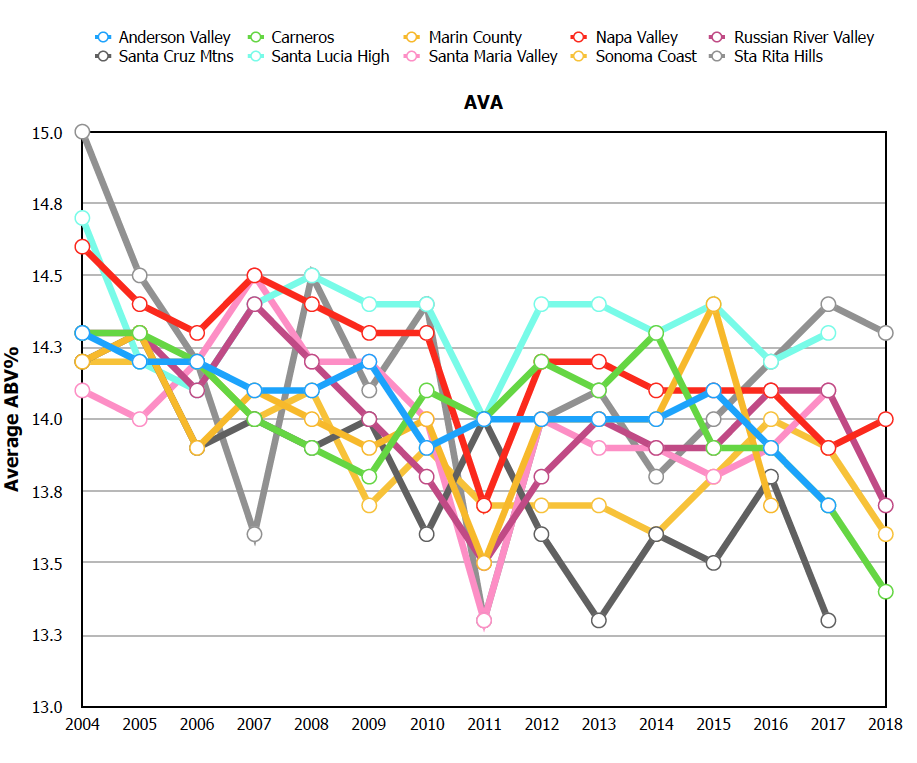
Featured Winery: Lumos Wine Company
Dai Crisp and his spouse PK McCovy, both Oregon State alumni, launched the Lumos Wine Company in 2000. Crisp was first exposed to viticulture in 1986 when he assisted his parents in planting a small, 10-acre vineyard on their farm in Wren, Oregon. He began his professional viticulture career at Croft Vineyards in 1990 and since 1999 has been managing Temperance Hill Vineyard, a 100-acre site in the Eola-Amity Hills appellation that is regarded by many, including myself, as one of Oregon’s premier “grand cru” Pinot Noir vineyards. Secure in the feeling that he could successfully grow premium grapes, Dai decided to start his own label. The name “Lumos” is derived from The Sorcerer’s Stone (The Philosopher's Stone in England) by JK Rowling. Dai and PK wanted a name that referred to magic or light and they discovered a name that referred to both in this book. As parents, they read this book out loud to their children and these reading sessions became an important family ritual, helping to make reading important to a new generation. Lumos refers to photosynthesis and magic, that is sunlight into wine. Dai grows all the grapes used in Lumos wines in USDA/Oregon certified organic vineyards including the family’s home Wren Vineyard in Philomath (15 acres planted to Pommard Pinot Noir, Pinot Gris and Dijon Chardonnay), the ‘Rudolfo’ Logsdon Ridge Vineyard (10-acres planted solely to Pinot Gris located just north of Corvallis) and the Temperance Hill Vineyard. Four of the Pinot Noir wines in this spring 2020 release are from the Temperance Hill Vineyard. This cool, late-ripening site located at 680-900 feet elevation was planted mostly to Pinot Noir first planted from 1981-1983 by owner Edward Koo. The vineyard is directly exposed to the Van Duzer Corridor leading to large daily temperature swings that result in good flavor development and bright acidity. Soils are shallow, lean, and basalt in type. Row spacing of the original plantings is 12’ x 8’ with 454 vines per acre.
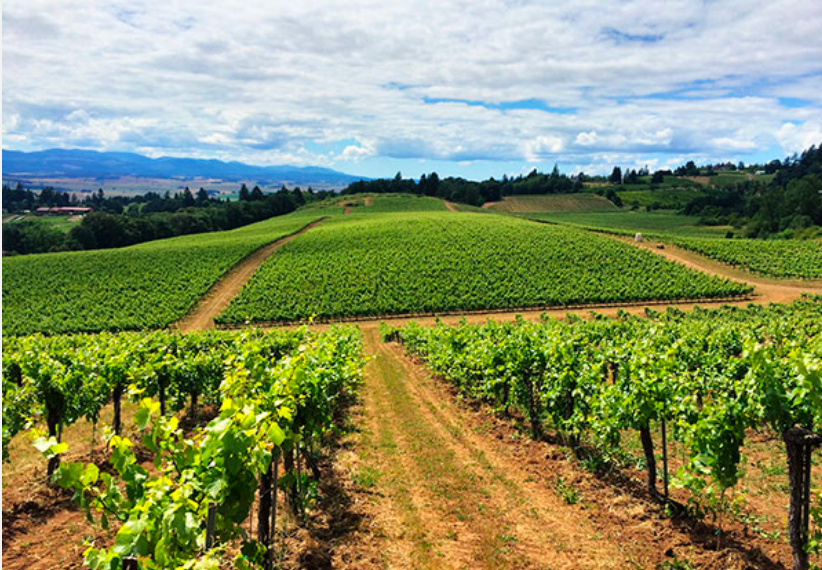 The original vines are on high wires with a hanging trellis. They are divided into three blocks: Front and The Flats (Pommard clone) and West Field (Wädenswil clone). All of the old vines are severely afflicted with phylloxera and trunk disease. 40% or less of the roughly 38-year olds are still producing fruit. More recently planted Pinot Noir clones in the Temperance Hill vineyard include 113, 114, 115, 667, 777, 943 and Swan. The blocks vinified by Lumos include the North (Pommard), the Pumphouse (113,114,115) and The G (777). All of these blocks are on grafted rootstock. Temperance Hill Vineyard grapes are also sourced by many of Willamette Valley’s most notable wineries including Adelsheim, Belle Pente, Brooks, Domino IV, Evesham Wood, J.K. Carriere, Love & Squalor, Penner- Ash, St. Innocent and Walter Scott. Lumos wines are vinified in McMinnville by winemakers Dai Crisp and Julia Cattrall. Dai was the initial Lumos winemaker but in 2007 Julie was hired and now guides the winemaking. Dai and his son Boone still collaborate on the direction of winemaking. Over time, there has been a move to a less extractive approach that together with other techniques have given the wines more focus and depth. No animal by-products or GMOs are used in the winemaking process so the wines are vegan friendly. The Lumos tasting room is located on the Crisp family farm in Wren, Oregon. A bit out of the way in Southern Willamette Valley but worth the trip. A cabin left standing on the property from the H bar H Dude Ranch that occupied the property in the 1940s was converted into a charming tasting wine. A vineyard cabin on the farm is available for Lumos Wine Club members and through VRBO. Lumos wines are sold through the winery’s website store at www.lumoswine.com. Dai and PK below.
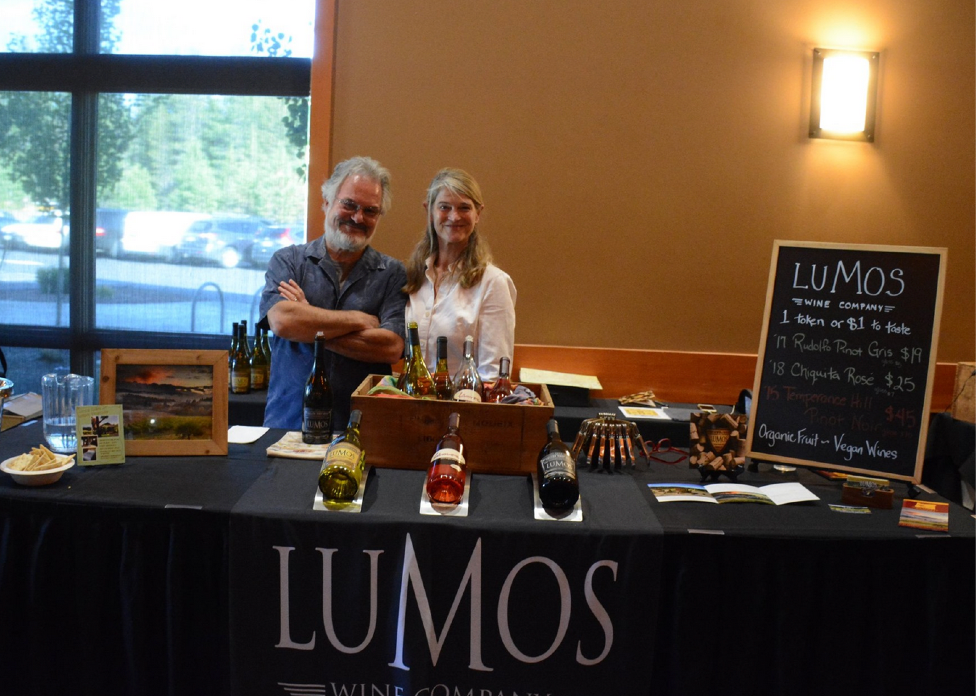
2017 Lumos Temperance Hill Vineyard Eola-Amity Hills Willamette Valley Pinot Noir 13.5% alc., 260 cases, $45. Vineyard is dry-farmed and 100% certified organic and Salmon Safe. This bottling is made from the best barrels among all the different lots. It generally includes most, if not all of the clones but there is no formula. Dai, Boone and Julia blind taste all the barrels and then arrive at a Temperance Hill Vineyard designate. Additional trials are then assembled by Julia and are evaluated blind. 1/3 whole cluster fermentation (layer cake method with whole clusters in the center), native yeast fermentation, primarily pump-overs with minimal punch-downs, and aged 15 months in French oak barrels. · Moderate garnet color in the glass. The pleasing aromas of black cherry, baking spice and toast gain traction over time in the glass. Delicious midweight flavors of black cherry and blackberry framed by uplifting acidity and tame tannins. Very open and giving with a compliment of oak in the background and some graphite-infused fruit on the finish. Score: 93
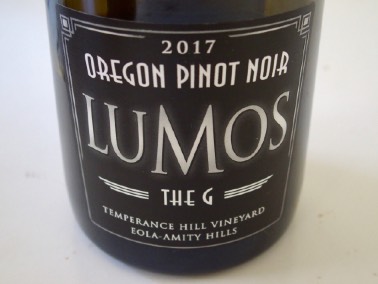 2017 Lumos The G Temperance Hill Vineyard Eola-Amity Hills Willamette Valley Pinot Noir 13.0% alc., 97 cases, $48. Also named “Guam” because this block is located in the farthest corner of the vineyard. Clone 777. 1/3 whole cluster fermentation (layer cake method with whole clusters in the center), native yeast fermentation, primarily pump-overs with minimal punch-downs, aged 15 months in French oak barrels. · This wine is a candidate for decanting, becoming my favorite wine in the 2017 lineup when tasted the following day from a previously opened and re-corked bottle. Superb intensity of fruit aromas including darker cherry and berry. Structure and power to spare, staining the palate with a charge of earth-toned blackberry fruit. A soft mouthfeel creates a velvet hammer of flavor. Echos of spiced dark fruit linger on the finish. An excellent cellar candidate. Score: 95
2017 Lumos Pumphouse Temperance Hill Vineyard Eola-Amity Hills Willamette Valley Pinot Noir 13.5% alc., 84 cases, $48. Clones 113, 114 and 115.1/3 whole cluster fermentation (layer cake method with whole clusters in center), native yeast fermentation, primarily pump-overs with minimal punch-downs, aged 15 months in French oak barrels. · Moderate garnet color in the glass. Reserved aromas of cherry, dark red berry, spice and floral perfume pick up intensity with time in the glass. Dense yet energetically fruited in a mid-weight plus style, with impressive fresh-off-the-vine expression of black grape, black berry and black currant flavors. Silky in the mouth with modest tannins and a finish awash in umami and fruit. Score: 94
2017 Lumos Upper Bench Temperance Hill Vineyard Eola-Amity Hills Willamette Valley Pinot Noir 13.5% alc., 69 cases, $48.1/3 whole cluster fermentation (layer cake method with whole clusters in the center), native yeast fermentation, primarily pump-overs with minimal punch-downs, aged 15 months in French oak barrels. · Moderate garnet color in the glass. A nose to kill for with hi-tone aromas of dark cherry and spice. Gracious in the mouth, with a pleasing infusion of dark red berry and cherry fruit flavors backed up with silken tannins and gregarious acidity. Excellent harmony, finishing long and savory. Score: 93
2017 Lumos North Wren Vineyard Willamette Valley Pinot Noir 13.5% alc., 96 cases, $48. Pommard clone. 1/3 whole cluster fermentation (layer cake methods with clusters in the center), natural yeast fermentation, primarily pump-overs with minimal punch-downs, aged 15 months in French oak barrels. · Moderate garnet color in the glass. This wine leads with the most seductive Pinot aromas of black cherry, cinnamon spice, sage and damp earth. Mid-weight in style, with engaging flavors of black cherry, dried herbs and vanilla. Completely satisfying, with a silky texture, minimal tannins and a cherry-fueled finish. Better than mother’s milk. Score: 94
2017 Lumos Julia Temperance Hill Vineyard Eola-Amity Hills Willamette Valley Pinot Gris 13.5% alc., 77 cases, $24. Released April 2020. Named for winemaker Julia Cattrall.Tank and barrel fermented. Coldstabilized, Bentonite fined. · Moderate golden yellow color in the glass. Nicely perfumed with aromas of pear, lemongrass, yellow melon, caramel and white flower. Engaging flavors of white stone fruits with a hint of coconut and the grassy character found in Sauvignon Blanc. Refined, with a moderately plush texture and an upbeat, uplifting finish. Score: 90
Pinot Briefing
Gregory Jones Talks Air Quality in Oregon Interviewed for The Newberg Graphic at www.pamplinmedia.com, Gregory Jones is Oregon’s foremost expert and how climate variability and change influence grapevine growth, wine production and wine quality. Jones said The weather conditions leading to the current condition in Oregon were a once in a generation event. The dry, hot air would have impacted wine grape flavors even without the wildfires but the fact that the fires occurred during harvest season is significant since ripe and overripe grapes are sensitive to smoke exposure leading to smoke taint.” Which Winegrape Varieties are Grown Where The new 2020 edition of this book is set for publication this month and can be downloaded free at www.adelaide.edu.au. Newer data from 2016 gives an updated review of wine grape plantings throughout the world. The authors, Kym Anderson and Signe Nelgen note that varietal diversity has decreased both nationally and globally. Top expanded plantings from 2000 to 2016 globally show Tempranillo number one with +311,375 acres. Pinot Noir is seventh with +90,613 acres. There is an increasing dominance of winegrapes of French origin in New World vineyards. Varietal bearing areas compared:
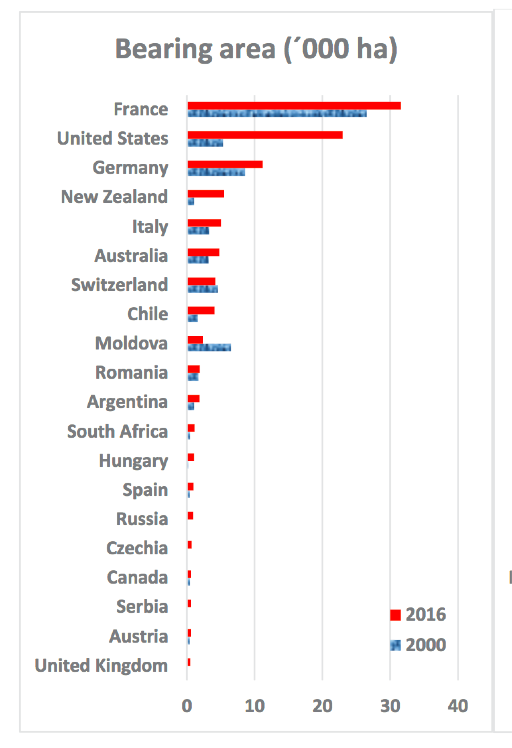 What Wineries are Saying About Smoke Taint Affecting the 2020 Harvest From Claude Koeberle and Don Plumley of Soliste (Sebastopol, CA): “We spare no expense and efforts, there are no compromises at Soliste and every decision is made solely for the excellence of the wines and nothing else will do. We made the extremely difficult decision that we will not pick in 2020. 2020 was not shaping up as a stellar vintage anyway what with extreme heat, warm nights and short hang time all conspiring against depth and complexity that are vital to the wines we craft. Add COVID-19 and the devastating August wildfires in the middle of Sonoma County just before harvest. To pick in these extreme conditions and be uneasy that field workers and the winery crew are safe to produce a probably smoky wine that would not meet our standards and core philosophy is not what Soliste is about. Smoke is the elephant in the room. with increasing frequency, Burgundy has hail that shatters their vineyards. Wildfire smoke is out invisible hail. It destroys a crop but seductively keeps the grapes on the vines. Even if it is not apparent at first, it is known to show up years later after the wine is in the bottle. For us, this risk is unpalatable. For Pinot Noir clusters, with their thin, delicate skins that are the source of the complexity and exotic flavors, smoke is exceptionally damaging.” From De Ponte Cellars (Dundee Hills, OR) comes this note from the Baldwin Family proprietors: “September in the Willamette Valley is a busy and exciting time as the culmination of the work in the vineyard as the grapes ripen, are then brought to the winery to be made into world-class wine that we have become known for. This September, much like the bulk of 2020, has looked entirely different for the Willamette Valley and De Ponte Cellars. Due to the tragic wildfires that are throughout our beautiful state, we have been under a heavy blanket of smoke for over a week. The air quality in our valley has ranked as the worst in the world day after day. Our enduring efforts at De Ponte center around the quality of our wine and we aim to make nothing but the best. This principle is what guides the decision to not produce wine from our estate vineyards this vintage. The wine produced is all but guaranteed to fall below our threshold of quality.” From Dan Goldfield at Dutton-Goldfield (Sebastopol, CA): What a strange harvest season it has been. The fires near us have thankfully gotten under control and we were bringing in some fruit that was ripe and ready to come in, while we tested berries from other sites that were still several weeks away from harvesting. Sadly, we have gotten results from several vineyards now which showed elevated levels of smoke exposure so we are not able to pick these grapes to make our wines. It seems that red grapes are more susceptible, and red wines are made by extracting flavor and color from the skins where the smoke and ash have had contact, so we will have a fairly reduced offering of 2020 red wines for you. The good news is that white grapes appear to be less impacted, plus the skin isn’t utilized for white winemaking and an attempt is made to very gently press the juice from the berries.” Several other Pinot Noir focused wineries are foregoing harvest such as Big Basin Vineyards, Trombetta Wines, Terra de Promissio, Pfendler Vineyards and Smith Story Wine Cellars. Research by Dr Eric Herve of ETS Laboratories on smoke taint conducted since the California fires of 2008 was reported in 2018. His studies revealed that volatile smoke compounds can be absorbed by grapes and leaves and become attached to sugars (“glycosylated”). During fermentation, the compounds are freed from their sugar attachment and cause smoke taint to appear in wine. Labs such as ETC have developed marker compounds to estimate the risk of wine smoke taint, specifically guaiacol and 4-methylguaiacol. Smoke taint risk is lower when fire events happen earlier in the season. Washing the grapes and reducing the maceration time for red wines does not reduce smoke taint. A number of filtering techniques have been attempted to remove smoke taint but none will remove all of the smoky aroma and flavor from significantly affected fruit. ConeTech, located in Northern California, advertises that it can isolate and remove the smoke-related flavor volatiles and add the flavor elements back. Want to taste smoke-tainted Pinot Noir? Find a bottle of 2008 Anderson Valley or Sonoma Coast Pinot Noir. I personally cannot tolerate the gamy, ash-like flavor but it is said that 25% of people don’t recognize smoke taint in red wine. As I ready this issue for publication a new devastating fire (Glass Fire) has broken out in St. Helena moving westward to Santa Rosa. Chateau Boswell, Newton Vineyard, Burgess Cellars, Castello di Amorosa and other wineries severely damaged or burned to the ground. Meadowood Resort and Calistoga Ranch had significant damage. Apoplectic and I am terribly saddened.
Quickies
2018 Adelaida HMR Estate Vineyard Paso Robles Chardonnay 13.7 alc., 408 cases, $40. Aged 9 months in 30% new French oak barrels. · Light golden yellow in color, leading off with pleasing aromas of lemon and flint. Creamy in the mouth and citrus-driven, with accents of white peach, roasted nuts and ocean salt spray. Highly enjoyable with invigorating acidity and some finishing length. Score: 92
2017 Cobden Wini Russian River Valley Pinot Noir 13.6% alc., 125 cases, $50. Released 6/15/20. A blend of fruit from Hogan’s run and Moore Family vineyards, clones 667, 777 and Pommard. Aged 11 months in 40% new French oak barrels. · This is a very solid wine featuring blackest cherry and black raspberry fruits that are married perfectly with the tannins and acidity. Peaking over time in the glass, this lovely wine has a lavish finish replete with fresh dark fruits that hang on. Score: 93
2018 Dutton Estate Winery Karmen Isabella, Dutton Ranch, Russian River Valley Pinot Noir 14.5% alc., 942 cases, $46. Released September 2020.A blend of fruit from Green Valley Road Vineyard, Thomas Road Vineyard and Manzana Vineyard. Dijon 115 and faux 828 clones. 100% de-stemmed, aged 11 months in 45% new French oak barrels. · Engaging aromas of black cherry and oak spice. Very flavorful mid-weight core of black cherry and black raspberry fruits with a touch of spice and thistle. Excellent upon opening with a smooth mouthfeel and admirable balance. Score: 93
2018 Dutton Estate Winery Warren’s Collection Dutton Ranch Russian River Valley Chardonnay 14.2% alc, 109 cases, $55. Released October 2019. Fruit from Dutton’s Ranch original Chardonnay vineyard, The Shop Block, planted in 1967 to Wente clone, is located in the Green Valley region of the Russian River Valley. 50% MLF (in barrel only). 50% aged in concrete egg and 50% aged in 50% new and 50% neutral French oak barrels. · bright aromas of lemon peel, pineapple and pear. Full-flavored in a citrus-imbued style that is seductively creamy on the palate. This wine walks the line between fruit-driven and acid-driven. Oak plays a very subtle role. Score: 93
2009 Gypsy Canyon Trois Sta. Rita Hills Pinot Noir 13.0% alc. · A harmonious wine holding its own after 11 years, featuring a rich core of dark berry fruits with a hint of friendly oak in the background. Similar in style to Paul Lato Pinot Noirs who consulted on this beauty. Unfortunately, Gypsy Canyon is no longer in business. Score: 94
2012 La Rue Emmaline Ann Vineyard Sonoma Coast Pinot Noir 12.4% alc. The whole cluster-inspired nose offers aromas of cherry, burnt tobacco and spicer. · Moderately light in color and feminine in style but packs a flavor punch. A deep core of cherry, blueberry and raspberry fruit flavors is elevated by a burst of acidity. Silken in texture with gossamer tannins and a generously fruity finish. Drinking at its peak now. Score: 93
2009 Littorai One Acre Anderson Valley Pinot Noir 13.3% alc. · I have been dipping into my library of older vintages of Littorai Pinot Noir with considerable glee. This gorgeous wine is velvety in the mouth with layers of black cherry and black berry fruit flavors and a compliment of engaging spice. This wine is not all about fruit as there are aromas and flavors of underbrush and earthy flora. Score: 94
2017 LOLA California Pinot Noir 13.4% alc., $17.98, screw cap. · Aromas of strawberry, red cherry, charcoal and petrol. Light to mid-weight flavors replicate the nose. Silky in the mouth with balanced tannins, but the wine displays too much barrel adjunct. Score: 87
2003 McHenry McHenry Vineyard Santa Cruz Mountains Pinot Noir 13.5% alc., 172 cases, Double Magnum. Harvest Brix 25.0º, aged 1 year in French oak barrels. · Captivating aromas of cherry, cola and baking spices. Elegant and silky in the mouth, with light to mid-weight flavors of red cherry and red berry. Harmonious and singing all high notes at 17 years of age. Amazing freshness and finesse. Nothing beats large formats. Score: 94
2018 Morgan Boekenoogen Vineyard Santa Lucia Highlands Pinot Noir 14.3% alc., 114 cases, $65. Pommard 4 and Dijon 113. 100% de-stemmed, native yeast, aged 11 months in 40% new French oak barrels. · Pleasant but not exceptional aromas of earthy flora, dark rose petal and black cherry. Juicy and silky in the mouth, with mid-weight, earth-toned flavors of black cherry and purple berry. The tannins are well integrated and there is a vein of good acidity highlighted by the cut on the finish. Score: 90
2018 Morgan Tondre Grapefield Santa Lucia Highlands Pinot Noir 13.9% alc., 126 cases, $65. Clones 777 and 115.100% de-stemmed, aged 11 months in 40% new French oak barrels. · Enthralling nose with vibrant aromas of cherry, baking spices and sandalwood. Lighter weighted in this vintage, with a core of red cherry and red berry fruits framed by caramel oak. Very charming in style with soft tannins and good length on the finish. The light fruit is somewhat superseded by oak. Score: 91
2018 Morgan Rosella’s Vineyard Santa Lucia Highlands Pinot Noir 14.3% alc., 114 cases, $65. Pisoni selection. 100% de-stemmed native yeast, aged 10 months in 37% new French oak barrels. · A bit unusual for Rosella’s in that the fruit spectrum veers to dark red cherry and beer on the delicate nose and the lightweighted palate. Aromas of dusty earth and rose add appeal and the fetching harmony makes for easy drinking. The cherry-driven finish has a ghost of oak. Score: 92
2018 Morgan Garys’ Vineyard Santa Lucia Highlands Pinot Noir 14.0% alc., 98 cases, $65. Pisoni selection. 100% de-stemmed, native yeast, aged 10 months in 40% new French oak barrels. · Enticing and penetrating aromas of dark cherry, pomegranate, sandalwood and savory spices. Mid weight plus in heft, with highly flavorful black cherry, black raspberry and molasses flavors. Nicely balanced with integrated tannins and an extended finish. The most powerfully flavored of the 2018 Morgan Pinot Noirs tasted. Score: 93
2018 Morgan Highland Santa Lucia Highlands Chardonnay 13.8% alc., $28. Dijon 95, 96 and 76 and clones 4, 15 and 17 from Double L, Tondre Grapefield, Leavens and McIntyre vineyards. Barrel fermented in 33% new French oak barrels, partial MLF, aged 8 months. · Shy aromas of lemon, pineapple and seasoned oak. Delicately-oaken citrus fruits and pear flavors. Refreshing and simple. Score: 89
2018 Morgan Double L Vineyard Santa Lucia Highlands Chardonnay 13.6% alc., 779 cases, $44. Clones 76, 95, 17, 4 and 15. Barrel fermented and aged 10 months in 30% new French oak barrels. 100% MLF. · The aromas arriver over time in the glass revealing lemon balm, white peach and petrichor. Soft and elegant on the palate, with delicate but satisfying flavors of lemon and pineapple with a nutty oak background. Crisp, with a bright citrus-infused finish. Score: 92
2012 Privé Vineyard Joie de Vivre Chehalem Mountains Willamette Valley Pinot Noir 13.0% alc., 139 of 174 etched labels. · A glorious wine drinking at its peak with a flood of well-ripened blueberry and blackberry fruits wrapped in a touch of oak spice, The incredibly satiny texture alone will bring you to your knees. Score: 95
2017 The Winery SF North Coast Pinot Noir 14.1% alc., $30. · ak-spiced aromas of black cherry and ripe strawberry lead to an elegantly composed mid-weight, black cherry-driven wine. Instantly gratifying with hidden tannins and a compliment of oak in the background. Best vintage to date from this producer. Score: 91
A final heads-up: I recently plucked from my cellar and drank 2017 Walter Scott Freedom Hill, Temperance Hill, and Sojourner Pinot Noirs from the Willamette Valley. I drank for pleasure and not for review and all three of these wines were incredibly good. Walter Scott is in the top echelon of current Willamette Valley Pinot Noir producers and very highly recommended. I also have been drinking some older vintages of Soliste Sonoma Coast Pinot Noir including 2011 L’Espérance and 2013 Fôret. I find these wines very seductive and they will drink beautifully for several more years. |